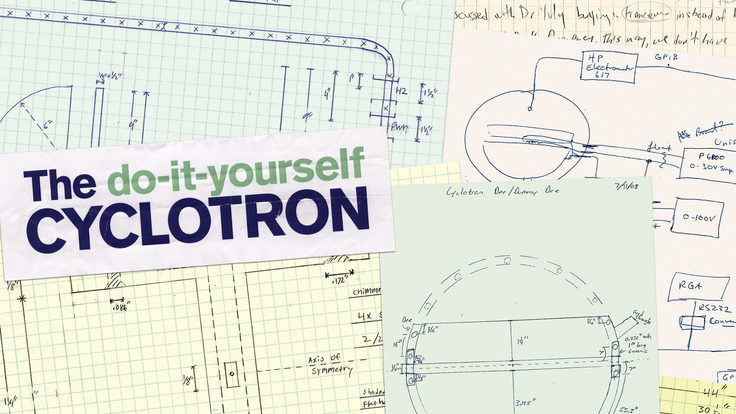Ever wondered what you would hear if you could shrink to the size of a proton, squeeze into the Large Hadron Collider beam pipe, and listen to particles colliding? Would there be sounds, noises, maybe even music? That’s what Lily Asquith, ATLAS scientist and head of the LHCsound project, believes.
Asquith started thinking about an “audio event display” while chatting with some musician friends. “I was trying to make the noises I hear in my mind's ear when I think of different particles moving through the detector,” she recalls. The project gradually took shape while Asquith finished her Ph.D. dissertation at University College London on the search for a low mass Higgs boson. In January, Asquith was awarded a grant from the UK’s Science and Technology Facilities Council for the sonification of ATLAS data, and she’s now leading a small team of two musicians/programmers, Archer Endrich and Richard Dobson from the Composer’s Desktop Project (CDP), and one illustrator, Toya Walker. The core development team is flanked by Ed Chocolate, DJ and producer, and Sir Eddie Real, percussionist, who are starting to incorporate sonified ATLAS data into their live performances.
Sonification is a technique that turns data into sounds while retaining all the original information contained in the data. A simple example is the beeping sound of a car parking sensor: the frequency of the beeps is related to the distance between your car and the obstacle, so that the closer you get, the higher the frequency. Sonification is also used in helping blind people to see, predicting earthquakes and identifying micrometeoroids impacting the Voyager II spacecraft.
The challenge for LHCsound is to find a coherent framework to map into sound the wide variety of abstract processes and variables involved in LHC experiments, such as the distribution in space and time of the particles emerging from a collision, the evolution of particles traveling through and interacting with matter, or even Feynman diagrams. A typical working session for the team includes a lively exchange of ideas (as well as computer programs and sound files) between the physicist and the musicians; whenever they are at a loss for words, diagram-drawing and strange vocalizations come into play.
“I bombard Dobson with crazy ideas for things like deconstructing a jet [of particles],” explains Asquith, “and he somehow understands what I am wittering on about and tells me what he needs to make the sound. Then I hack up bits of ATLAS software, stick them together and run over data to produce files of the format he needs.”
While Dobson created software to transform ATLAS data directly into sounds, Archer worked on converting these data in a format that can be used by the CDP software and thus be available for composers. Just three columns of numbers extracted by Asquith from the ATLAS reconstruction program gave birth to a wealth of sonifications of the quark jets generated from a decaying Higgs boson, with sound bites up to 90 seconds long.
The LHCsound website’s artwork is inspired by a similar brainstorming between Asquith and Walker, who discuss basic concepts like what makes particles different from one another. One discussion about the philosophical implications of finding the Higgs boson led to a portrait of the elusive particle as the Golden Snitch from the Harry Potter books.
Asquith is convinced that sonification could be useful for physics analyses. Our hearing system is a sophisticated neural network, capable of extracting a wealth of information from the sounds we listen to, with amazing precision – just the qualities that physicists expect from their analysis software. So, although the project was born as an outreach and musical composition endeavor, it might turn out to also have an impact on particle physics research.
Physicists’ curiosity about what particles sound like isn’t confined to the LHC. Across the Atlantic, physicists Agnes Mocsy from the Pratt Institute in New York and Paul Sorenson from Brookhaven National Laboratory teamed up with Alex Doig, senior illustration major at the Pratt Institute for “The Sound of the Little Bang” project. The “little bang” is what some physicists call the collisions between heavy nuclei inside particle accelerators, since they reproduce the condition of matter as it existed only millionths of seconds after the Big Bang. Brookhaven’s Relativistic Heavy Ion Collider smashes gold ions at nearly the speed of light to produce a peculiar type of matter called quark-gluon plasma. The plasma behaves like a liquid, and therefore sound waves should be able to propagate into it. Mocsy and Sorenson analysed the available RHIC data and obtained the sound produced by the quark-gluon plasma as it expands and cools down. The group posted a YouTube video describing the project and accompanying the sound with animation.
Both the LHC and RHIC projects aim at bringing science closer to the public in an innovative way, through music. Music is also the medium chosen by musician and producer John Boswell for his “Symphony of Science” – a series of inspiring digital mashups featuring famous scientists and science communicators like Carl Sagan, Richard Feynman and Brian Greene. Audios and videos from television programs and interviews are sampled and mixed, voices are pitch corrected and Boswell’s original compositions are added as soundtracks. The first video has collected almost 4 million hits on YouTube since its release in Fall 2009, and four more have since been produced. With the wealth of sounds now becoming available via sonification projects, perhaps a future Symphony of Science video will feature sounds from real RHIC or LHC data!
-- Manuela Cirilli






